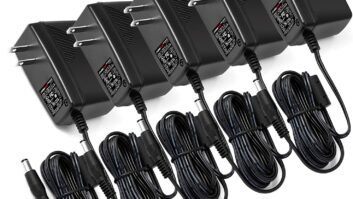
Larry Langford replaced costly insulators with PVC. Larry Langford is chief engineer and owner of WGTO(AM/FM) in Cassopolis, Mich. He writes that one of the mysteries of radio is why porcelain standoff insulators in phasors and ATU units crack and shatter for no apparent reason. Larry is sure it has to do with thermal shock and a host of other things; but there’s no question that when they go, they need to be fixed.
These supports are not cheap, and the replacements are just as fragile. So you ask yourself if there is a better way.
A quick run to the hardware store produced an acceptable replacement for Larry, and perhaps for you, too. Larry selected 3/4-inch PVC with end caps. You can fabricate a nice replacement for lower-power operations that way.
Simply cut the PVC a half-inch shorter than the porcelain standoff and drill the end caps for 1/4-20 inch stainless hardware. Insert a screw in the cap and then press it on the PVC tube and mount it to the panel by screwing the tube down.
Then drill the other end cap and mount the hardware and tighten as required. Once the hardware is installed, slip the end cap over the open end of the PVC and you now have a great and cheap replacement. No need to use PVC cement. The caps will hold fine by friction.
You can add PVC cement if you desire, but getting the hardware off after using the cement will be a challenge. Either way, no more shattered insulators!
Fig. 1 shows a J-Plug jack held with the PVC insulators. Fig. 2 shows another application.
While Larry doesn’t know the exact “leakage” of PVC, the voltage rating is the point of concern. The porcelain insulators are selected to insulate components from ground. The caution is to not use this kind of standoff at high current or voltage points within the network.
* * *
I received several calls from readers who were delighted with Buc Fitch’s dummy load project.
RW reader James Walker wasn’t as impressed. He writes: “I like to build things, too, but how much is your time worth? Even if the parts were only 20 bucks, the couple of hours spent cobbling it together had to raise the price well above a hundred.
“At the Dayton Hamvention a couple of years back, a two-way outfit was selling 50-watt cell wave reject loads with Type N connectors for 10 bucks each. I bought several. They’re good to well beyond a gigahertz — 1.1 to 1,” he continued.

The end caps permit mounting in low-voltage applications. “If I’m on a client’s dime, I’m more than a bit leery of spending time this way. If it’s my time, I can build another throttle for my trains in about the same time (and about the same parts cost). My 2,500-watt Bird oil load was less than a hundred at the hamvention.
“Building is fun, and I’ve ‘imagineered’ all sorts of little gizmos. But I’ve found that I can buy used and leverage my budgets (both time and money). Just a thought.”
Buc Fitch thanked Walker for the honest comments. Buc replies further:
“You know, it’s funny that you should bring forward this thought of time vs. worth today.I spent the morning at a hamfest and most of what I saw was, sadly, appliances operators. People bragging about how well the gear bought from a catalog from someone else’s recommendation made them unique.
“What did they bring of themselves? What did they learn? What skills did they acquire and polish? If you discount snapping cables together or loading someone else’s software … they really did not furnish any personal input,” Buc muses.
“If radio is just a business or being a ham is just a virtual experience to you, then more power to you, as you are getting what you want — which is not much.
“The dummy load project is not so much about saving money but mainly a vanity, sanity sort of thing. All the little projects and ideas that I’ve been writing about over the last 20 years are just departure points to put your own uniqueness on a final design and assembly. To wit, our little project to interface computer headsets to balanced 150-ohm inputs has precipitated about 10 permutations from readers.
“To paraphrase one of my most astute mentors, you learn by doing. You learn most from your mistakes, which you cannot make unless you do something … and what is real thinking but coupling ideas together? Even a little project like this can yield incredible benefits, especially for neophytes.”
* * *
IT manager and engineer Alan Jurison ran across a recall for APC surge suppressors manufactured before 2003. The affected models are pretty common; Al has seen them at broadcast stations as well as in his office! Affected products should be taken out of service immediately due to the risk of fire, and the owner should be advised to follow the instructions found on the APC Recall Site: recall.apc.com.
Even if you did not personally purchase these products, do a thorough inspection: under desks, inside racks and under consoles. Following a claims information and validation process, APC is offering customers a replacement product that is the same model/type, or a functionally equivalent model, at no charge.
Contribute to Workbench. You’ll help your fellow engineers, and qualify for SBE recertification credit. Send Workbench tips to [email protected]. Fax to (603) 472-4944.
Author John Bisset has spent 44 years in the broadcasting industry and is still learning. He handles West Coast sales for the Telos Alliance. He is SBE certified and is a past recipient of the SBE’s Educator of the Year Award.












